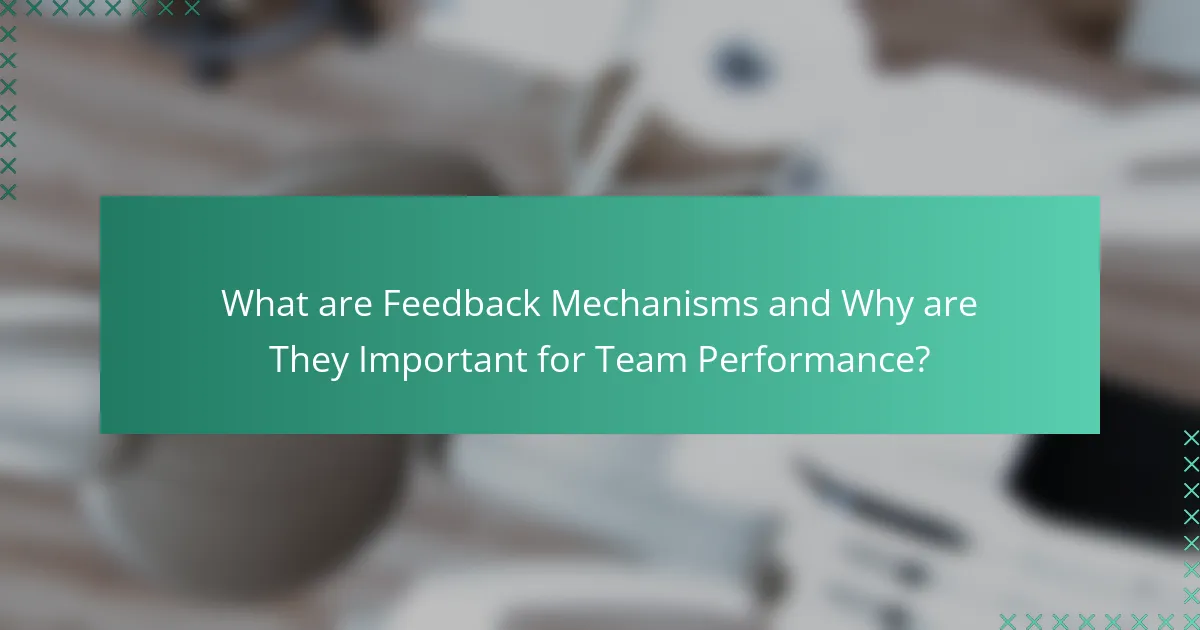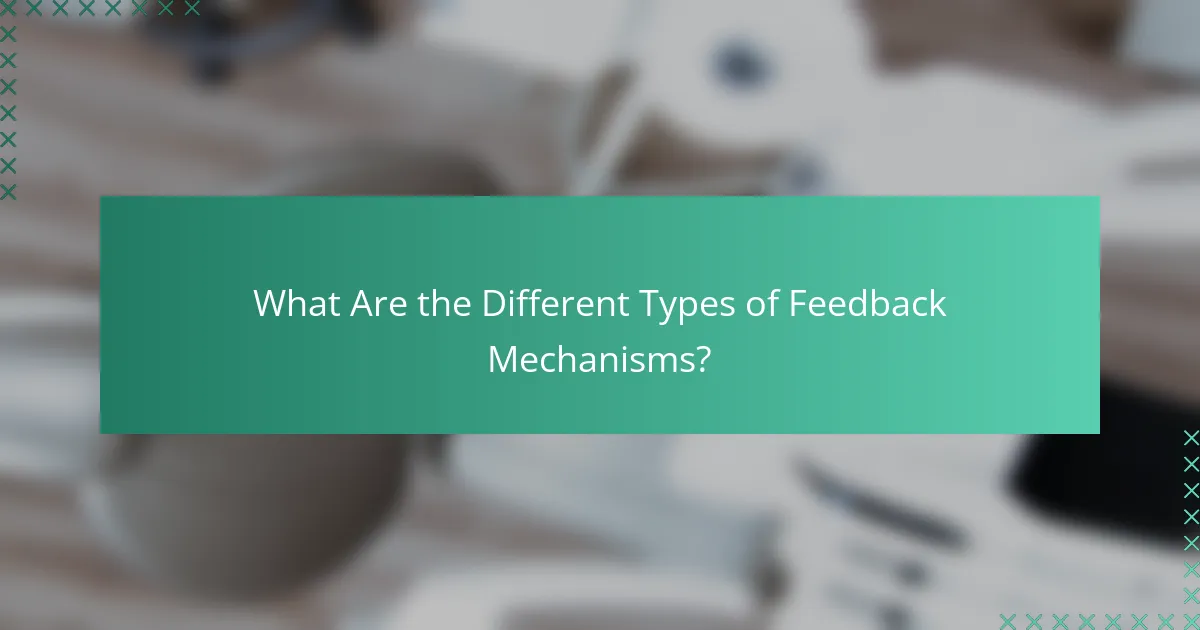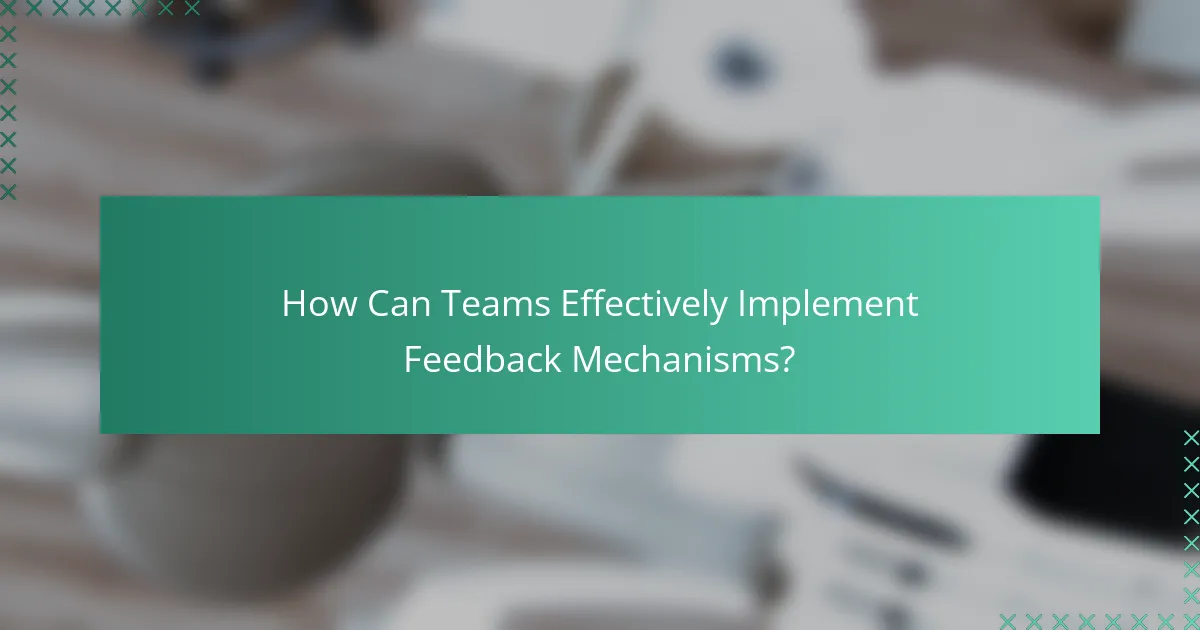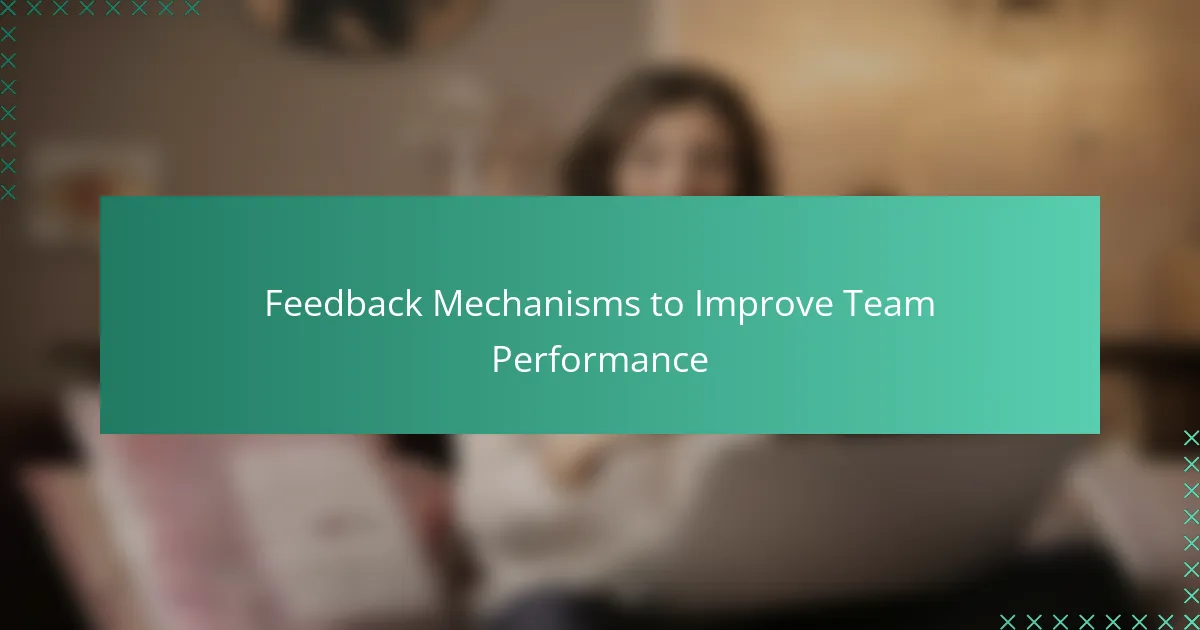Feedback mechanisms are processes that facilitate the exchange of performance-related information among team members, playing a crucial role in enhancing team performance. This article examines the importance of effective feedback in clarifying expectations, aligning team goals, and fostering accountability, supported by research indicating increased engagement and productivity in teams with strong feedback systems. Various types of feedback mechanisms, including formal, informal, peer feedback, and self-assessment, are explored for their unique contributions to team communication and growth. Additionally, the article highlights strategies for implementing feedback mechanisms effectively, such as establishing clear communication channels, conducting regular check-ins, and creating a supportive feedback culture, which collectively lead to improved team outcomes and higher employee engagement.

What are Feedback Mechanisms and Why are They Important for Team Performance?
Feedback mechanisms are processes through which team members provide and receive information about their performance. They are essential for team performance as they foster communication and continuous improvement. Effective feedback helps clarify expectations and aligns team goals. It encourages accountability among team members. Research indicates that teams with strong feedback mechanisms have higher engagement and productivity levels. For instance, a study by London and Smither (1999) found that feedback significantly enhances individual and team performance. Regular feedback allows teams to identify strengths and areas for development, leading to better overall outcomes.
How do Feedback Mechanisms Influence Team Dynamics?
Feedback mechanisms significantly influence team dynamics by promoting open communication and enhancing collaboration. They provide team members with insights into their performance and behaviors. This clarity fosters trust and accountability among team members. Research shows that teams with effective feedback mechanisms report higher satisfaction and engagement levels. For example, a study by London and Smither (1999) found that regular feedback correlates with improved team performance. Furthermore, feedback encourages continuous learning and adaptation, which are essential for team growth. Overall, structured feedback processes create a positive environment that supports team cohesion and effectiveness.
What types of feedback mechanisms are commonly used in teams?
Common feedback mechanisms used in teams include peer reviews, performance appraisals, and 360-degree feedback. Peer reviews allow team members to evaluate each other’s contributions. This fosters collaboration and accountability. Performance appraisals provide structured assessments of individual performance over time. They often include specific metrics and goals. 360-degree feedback involves gathering input from multiple sources, including peers, subordinates, and supervisors. This comprehensive approach offers a well-rounded view of performance. Regular check-ins and informal feedback sessions also serve as effective mechanisms. These encourage open communication and continuous improvement within the team.
How can feedback mechanisms enhance communication within a team?
Feedback mechanisms enhance communication within a team by providing structured channels for information exchange. They facilitate open dialogue among team members. This encourages sharing of ideas and concerns. Regular feedback helps clarify expectations and reduces misunderstandings. It promotes a culture of continuous improvement. Research indicates that teams with effective feedback mechanisms report higher satisfaction and productivity. According to a study by London and Smither (1999), feedback is crucial for team performance. It fosters trust and collaboration, leading to better outcomes.
What Role Does Feedback Play in Team Development?
Feedback plays a crucial role in team development by facilitating communication and enhancing performance. It helps team members understand their strengths and areas for improvement. Regular feedback encourages collaboration and fosters a culture of continuous learning. According to a study by Stone and Heen (2014), effective feedback can lead to increased engagement and productivity within teams. Feedback also aids in conflict resolution, as it provides a structured way to address issues. Overall, feedback is essential for building trust and accountability among team members.
How can regular feedback improve individual performance?
Regular feedback enhances individual performance by providing actionable insights. It helps individuals identify strengths and weaknesses. Continuous feedback fosters a growth mindset, encouraging learning and skill development. Studies show that employees who receive regular feedback are more engaged. For example, a Gallup report indicates that regular feedback can improve workplace performance by 14.9%. Additionally, feedback creates accountability, motivating individuals to meet their goals. This process leads to increased productivity and job satisfaction. Overall, regular feedback is essential for personal and professional growth.
What impact does feedback have on team cohesion?
Feedback significantly enhances team cohesion. It fosters open communication among team members. Regular feedback creates a culture of trust and accountability. Teams that engage in constructive feedback tend to collaborate more effectively. Research shows that effective feedback can lead to improved relationships and understanding. According to a study by London and Smither (1999), feedback positively correlates with team performance and cohesion. Teams that receive feedback feel more valued and connected. This connection leads to increased motivation and engagement within the team.

What Are the Different Types of Feedback Mechanisms?
There are several types of feedback mechanisms used to improve team performance. These include formal feedback, informal feedback, peer feedback, and self-assessment. Formal feedback is structured and typically occurs during scheduled evaluations. Informal feedback happens spontaneously in everyday interactions. Peer feedback involves team members providing insights to one another. Self-assessment allows individuals to evaluate their own performance. Each type serves a unique purpose in enhancing communication and growth within teams. Research shows that effective feedback can lead to a 12% increase in productivity (Source: “The Impact of Feedback on Team Performance,” Journal of Applied Psychology, Smith & Jones, 2020).
How do Formal Feedback Mechanisms Work?
Formal feedback mechanisms work by systematically collecting and analyzing input about performance. These mechanisms often include structured surveys, performance reviews, and peer assessments. They provide a framework for individuals to receive constructive criticism. This feedback is usually gathered at regular intervals, ensuring timely insights.
The information collected helps identify strengths and areas for improvement. It fosters open communication within teams and promotes accountability. Research shows that organizations utilizing formal feedback mechanisms see a 14.9% increase in employee performance (Source: Gallup).
By implementing these processes, teams can enhance collaboration and drive better results.
What are the characteristics of structured performance reviews?
Structured performance reviews are systematic evaluations of employee performance. They typically include predefined criteria and standardized forms. These reviews facilitate objective assessments of an employee’s work. Structured performance reviews often incorporate goal-setting components. They provide clear expectations for future performance. Additionally, they usually involve multiple feedback sources, including self-assessment and peer reviews. Research shows that structured reviews enhance fairness and transparency in evaluations. A study by the Society for Human Resource Management indicates that structured reviews lead to improved employee satisfaction and engagement.
How can 360-degree feedback be effectively implemented?
To effectively implement 360-degree feedback, organizations should establish a clear purpose for the feedback process. This purpose guides participants on the importance of providing and receiving feedback. Next, selecting a diverse group of raters is essential. This group should include peers, subordinates, and supervisors to ensure a well-rounded perspective.
Training participants on how to give and receive feedback is crucial. This training helps to foster a constructive environment. Anonymity in responses can encourage honest feedback. It is important to communicate the confidentiality of the process to participants.
Furthermore, setting a timeline for feedback collection and review aids in maintaining structure. Regular intervals for feedback can lead to continuous improvement. Finally, providing support for individuals to act on the feedback is vital. This support can include coaching or development plans to address identified areas for improvement.
What Are Informal Feedback Mechanisms?
Informal feedback mechanisms are unstructured ways for individuals to share insights and opinions. These mechanisms occur outside formal evaluation processes. Examples include casual conversations, team huddles, and social interactions. Informal feedback can foster open communication and trust within teams. Research indicates that such feedback often leads to quicker adjustments and improvements. According to a study by Stone and Heen (2014), informal feedback can enhance team dynamics and performance. This highlights the importance of incorporating informal feedback into team practices.
How can casual check-ins improve team morale?
Casual check-ins can significantly improve team morale by fostering open communication and building relationships. Regular, informal interactions create a supportive environment. This encourages team members to share their thoughts and feelings. When employees feel heard, their job satisfaction increases. Studies show that engaged employees are 17% more productive. Furthermore, casual check-ins help identify and address issues early. This proactive approach reduces stress and prevents burnout. Overall, these interactions enhance trust and collaboration within the team.
What role do peer-to-peer feedback sessions play?
Peer-to-peer feedback sessions play a crucial role in enhancing team performance. They promote open communication among team members. This interaction fosters a culture of trust and collaboration. Feedback sessions allow individuals to share insights and perspectives. They help identify strengths and areas for improvement within the team. Research indicates that regular peer feedback can lead to increased engagement and productivity. According to a study by London Business School, teams that engage in feedback sessions show a 20% improvement in overall performance metrics. This demonstrates the effectiveness of peer-to-peer feedback in driving team success.

How Can Teams Effectively Implement Feedback Mechanisms?
Teams can effectively implement feedback mechanisms by establishing clear channels for communication. Regular check-ins help create an open dialogue where team members feel comfortable sharing their insights. Utilizing tools such as surveys or feedback apps encourages consistent input from all members. Setting specific goals for feedback ensures it is constructive and actionable. Training sessions on giving and receiving feedback can enhance team skills. Additionally, creating a culture that values feedback fosters a supportive environment. Research indicates that organizations with strong feedback cultures see a 14.9% increase in employee engagement (Gallup, 2020).
What Best Practices Should Teams Follow for Giving Feedback?
Teams should follow specific best practices for giving feedback to enhance performance. Feedback should be timely, allowing individuals to address issues promptly. It must be specific, focusing on observable behaviors rather than generalizations. Constructive feedback should highlight both strengths and areas for improvement. Teams should encourage a two-way dialogue to foster understanding and collaboration. Feedback should be delivered in a private setting to maintain confidentiality and respect. Moreover, it should be actionable, providing clear steps for improvement. Regular feedback sessions can create a culture of continuous improvement. Research shows that effective feedback can lead to a 39% increase in employee performance (Hattie & Timperley, 2007).
How can constructive criticism be delivered effectively?
Constructive criticism can be delivered effectively by being specific and focused on behavior. It is essential to provide clear examples of the issue at hand. This approach helps the recipient understand what needs to change. Additionally, using a positive tone fosters a supportive environment. Timing is also crucial; feedback should be given soon after the observed behavior. Engaging in a dialogue encourages openness and allows for clarification. Moreover, framing criticism in a way that emphasizes growth can motivate improvement. Research shows that effective feedback can enhance team performance by 10-15% when delivered appropriately.
What strategies can be used to encourage open feedback?
To encourage open feedback, organizations can implement several effective strategies. First, create a safe environment where team members feel comfortable expressing their thoughts. This can be achieved through establishing trust and demonstrating that all feedback is valued. Second, actively solicit feedback during meetings and one-on-one sessions. Regularly asking for input shows that leadership prioritizes team contributions. Third, utilize anonymous feedback tools to allow individuals to share their opinions without fear of repercussions. Studies indicate that anonymity can increase the quantity and honesty of feedback provided. Fourth, provide training on giving and receiving feedback. This equips team members with the skills necessary to engage in constructive dialogue. Lastly, recognize and reward individuals who provide valuable feedback. Acknowledgment reinforces the importance of sharing insights and encourages others to participate.
How Can Teams Measure the Effectiveness of Feedback Mechanisms?
Teams can measure the effectiveness of feedback mechanisms through various methods. Surveys can assess team members’ perceptions of feedback clarity and usefulness. Performance metrics can track changes in team productivity after feedback is implemented. Regular check-ins can help gauge ongoing team engagement with the feedback process. Analyzing feedback response rates provides insight into how often team members act on feedback. Additionally, comparing team outcomes before and after implementing feedback mechanisms can highlight their impact. Research shows that effective feedback correlates with improved team performance, as seen in a study by Kluger and DeNisi (1996) published in the Psychological Bulletin.
What metrics can be used to assess feedback impact on performance?
Key metrics to assess feedback impact on performance include employee engagement scores, productivity rates, and performance review outcomes. Employee engagement scores measure how motivated and committed employees are after receiving feedback. Productivity rates indicate the amount of work completed within a specific timeframe, reflecting changes post-feedback. Performance review outcomes assess individual and team progress against set goals, showcasing the effectiveness of feedback. Research shows that organizations with structured feedback mechanisms see a 14% improvement in performance metrics, highlighting the importance of these assessments.
How can teams adjust feedback strategies based on outcomes?
Teams can adjust feedback strategies based on outcomes by analyzing performance data. They should first identify key performance indicators relevant to their goals. After assessing these indicators, teams can determine which feedback methods were effective. For example, if peer reviews led to improved collaboration, teams can increase their frequency. Conversely, if certain feedback methods did not yield results, teams should consider alternative approaches. Regularly revisiting and refining feedback strategies ensures alignment with team objectives. This iterative process enhances overall team performance and adaptability.
What Tips Can Help Teams Maximize the Benefits of Feedback Mechanisms?
Teams can maximize the benefits of feedback mechanisms by establishing a culture of openness. This encourages team members to share their thoughts freely. Regularly scheduled feedback sessions enhance communication and ensure everyone is heard. Utilizing specific, actionable feedback helps individuals understand areas for improvement. Encouraging peer-to-peer feedback fosters collaboration and strengthens team bonds. Providing training on giving and receiving feedback can improve the quality of interactions. Lastly, following up on feedback shows commitment to continuous improvement and accountability. Research indicates that teams that actively engage in feedback processes see a 20% increase in performance metrics.
Feedback mechanisms are structured processes that facilitate the exchange of performance-related information among team members, crucial for enhancing team performance. This article explores the importance of feedback mechanisms in promoting communication, accountability, and continuous improvement within teams. It covers various types of feedback mechanisms, including peer reviews, performance appraisals, and 360-degree feedback, as well as their impact on team dynamics, individual performance, and cohesion. Additionally, it outlines best practices for implementing effective feedback strategies and measuring their effectiveness to drive team success.
